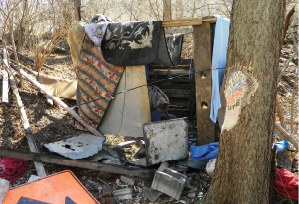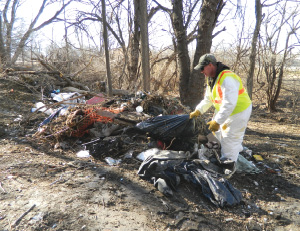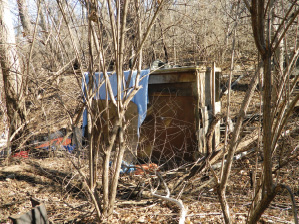
By MICHAEL BUSHNELL
Northeast News
January 23, 2013
If you’ve taken The Paseo entrance ramp to I-35 northbound any time recently you’ve no doubt noticed the blue and green tarps in the woods and the seemingly endless parade of foot traffic along the east side of the entrance ramp to the top of the hill where someone “flies the sign” to garner spare change, food, water and the occasional free beer or half pint of hooch. On the morning of Jan.18, however, acting on citizen complaints, workers with the city’s Parks and Recreation Department and police officers eradicated the encampments, discovering a number of “hot” portable meth labs in the process.
“It really was a pretty sophisticated kind of layout,” said one Parks Department worker as he stood in the middle of a “courtyard” of sorts that was once ringed by tents, tarps and shanties.
“This one here was a huge tarp that had separate sleeping quarters, a latrine and even a kind of patio area,” he said, pointing to a holed out area in the ground ringed by large stones.
The area is accessed only by a complex network of paths and walkways cut through the woods. Like cul-de-sacs off a residential street, tents and tarps were arranged around a central courtyard of sorts, all with separate cooking areas, latrines and clothes lines. Each latrine consisted of a five-gallon bucket with a toilet seat on top. When the bucket got “full,” it was removed to a ditch a short distance away, a new bucket was secured and the process started all over again.
Each cul-de-sac area off the main path housed five to seven tent spots, much like a modern campground. Farther down the main path in a secluded hollow, a makeshift cabin crafted from pallets, lumber, tarps and stolen street signs had been erected by an enterprising person. It was complete with windows and a port for cooking fire smoke to escape. Clearly, there’s a pecking order even among the homeless.
At one of the primary points of access to the encampments, a small bulletin board was wedged into a tree where printed messages could be left to occupants, reminiscent of the hobo camps of old with their own communication signs. It is estimated the complex network of trails and living areas along the hillside housed upwards of 150 people at any given time.
Police and Federal Bureau of Investigation officials accompanied the Parks Department workers in case any resistance was encountered by squatters and to deal with the hazards that come with portable methamphetamine labs.
“We picked up one of those piles and liquid just squirted out all over the place,” said one Parks Department worker who was clad in a white safety suit. “We found about five hot labs up here and another five or so down over the hill (toward Guinotte Avenue).”
Police made no arrests, but the police department’s Drug Enforcement Units systematically cleaned up the labs, eliminating the bulk of the hazard to Parks Department workers who were responsible for the clean-up.
“It’s a never ending cycle,” said another Parks Department worker. “We’ll be back here in six months and it’ll be built back up, probably better than this.”


















